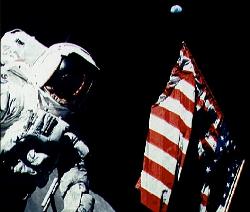
Despite the dearth of extraterrestrial field trips, aspiring lunar geologists can now help to map the surface of the Moon through a citizen science project called “Moon Zoo”, writes Sue Bowler.
Following the success of projects such as Galaxy Zoo, in which volunteers classify astronomical objects observed by large telescopes, Moon Zoo is asking volunteers to examine detailed images of the lunar surface and catalogue small craters, which helps to date the surface, measure boulder distribution in order to map properties of the regolith, and to look out for any unusual geological features, such as boulder tracks, or recent impact craters that may have supplied meteorites found on Earth. The data will add to the understanding of the geological evolution of the Moon, and may be useful in planning future landing sites, for humans or robotic missions. It will also provide a database of information to compare with, for example, automatic computer-based methods of crater counting.
The images that Moon Zoo uses are Planetary Data System high spatial resolution images (with associated metadata) from NASA’s Lunar Reconnaissance Orbiter Narrow Angle Camera (LROC NAC) instrument. They are so detailed that it is possible to identify boulders sampled by Apollo astronauts – and even to see the tracks of their lunar rover.
The Moon Zoo team hopes that this citizen science database will link together into a better geological history the events recorded by the lunar surface, and put in context the few ‘ground-truth’ samples from Apollo.